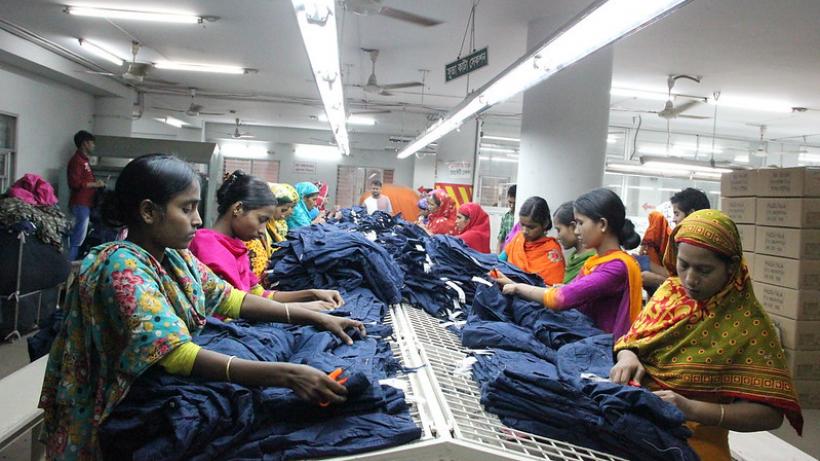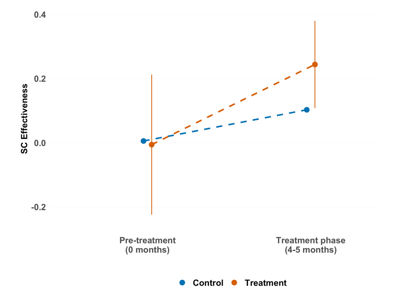
Improving labour standards: Enforcement interventions by multinationals in Bangladesh
When MNCs enforce garment factory Safety Committee law on external suppliers, compliance and safety indicators improve. Importantly, the degree to which they improve depends on the supplier’s organisational capacity.
In developing countries, governments often lack the capacity or the political will to update and enforce regulations (Dal Bó and Finan, 2016), including labour regulations. In response, many Western multinational corporations (MNCs) sourcing products and services from developing countries privately enforce local labour laws on their suppliers through Corporate Social Responsibility (CSR) programmes (O’Rourke, 2014).
Multinational corporations and labour regulation enforcement
In a globalised production system, CSR programs could provide an important source of regulation enforcement. It is an open question, however, whether MNCs have the incentives and capabilities to improve labour standards in developing countries. On one hand, MNCs have incentives to prevent industrial disasters that could pose reputational risks (Tadelis, 2002; McDevitt, 2011).
On the other hand, enforcement of labour laws may increase labour costs, which suggests that MNCs’ promises may not be credible without effective monitoring (Besley and Ghatak, 2007). Finally, even if MNCs are motivated to improve labour standards, it’s unclear whether they have sufficient bargaining power and monitoring capacity to influence suppliers’ practices (Short, Toffel and Hugill, 2016).
Further, if private enforcement of labour regulations can improve targeted establishments’ compliance, it raises the question of whether it generates net benefits or costs to these establishments and to their workers. Although limited, existing empirical evidence provides grounds for concern: It finds negative associations between increased de jure labour regulation and firm competitiveness as well as worker outcomes (Botero et al., 2004; Besley and Burgess, 2004).
Tragedy in Bangladesh’s garments sector
The 2013 Rana Plaza garments factory complex collapse in Bangladesh was one of the worst industrial disasters in modern history: Nearly 1,150 workers died and thousands of others were injured. The collapse was blamed not only on the building owner and the Government of Bangladesh (GoB), but also on the MNCs sourcing garments from Bangladesh. It spurred western MNCs to commit to large-scale initiatives to enforce safety-related labour laws on their Bangladeshi suppliers.
The MNCs, the GoB, and other members of the international community agreed to a division of responsibility for safety oversight of the sector for five years (International Labor Organization, 2017). The MNCs’ oversight included enforcement of safety-related amendments to the labour law passed in 2013. A mandate for worker-manager Safety Committees (SCs) was key among these amendments.
The study: Experimental labour law enforcement and compliance in Bangladesh
As an output of the International Growth Centre’s co-funded project, I assess the effects of MNC enforcement on establishments’ compliance with Bangladesh’s SC law. I conducted a randomised controlled trial (RCT) to experimentally vary establishments’ exposure to MNCs’ enforcement of the SC law.
To conduct the RCT, I partnered with a coalition of MNC retail and apparel firms, known as the Alliance for Bangladesh Worker Safety (hereafter, the Alliance), which formed following the Rana Plaza collapse. The Alliance’s membership included 29 multinational retail and apparel firms (e.g., Wal-Mart, Gap, Target).
Its SC enforcement programme involved a six-month SC intervention that aimed to bring establishments into meaningful compliance with the SC law. It entailed monitoring of SCs’ activities and a limited amount of capacity building for SC members.
The RCT was implemented over 2017-2018. It included 84 establishments (Bangladeshi garment factories):
- Treatment group: 41 establishments were randomly assigned to immediate participation in the Alliance’s SC enforcement programme.
- Control group: 43 establishments were randomly assigned to deferred participation in the enforcement programme 11 months later.
To collect data on establishments’ outcomes, the research team visited establishments three times: A pre-intervention baseline, a post-intervention round 4-5 months later, and a second post-intervention around 9-10 months after baseline. For treatment establishments, the 4-5-month data collection visit occurred toward the end of the 6-month enforcement programme.
The 9-10-month visit aimed to test whether the intervention’s effects persisted after the MNCs ceased intensive enforcement (but continued less intensive monitoring). I analyse the data according to a pre-analysis plan (PAP), which is registered on the American Economic Association’s Social Science Registry.
The findings: Does MNC-enforcement improve compliance and safety?
Compliance with the SC labour law entails fulfilling numerous requirements. For this reason, to capture the intervention’s general effect on compliance, I use a summary index of compliance-related outcomes. I also take this approach for my main test of treatment effects on SCs’ effectiveness at improving safety.
- Establishment compliance
My first finding is that when MNCs enforce the SC law, treatment establishments’ compliance with the law significantly improves. Panel A illustrates the pre- and post-intervention compliance differences between treatment and control establishments. The treatment group’s improvement is primarily driven by SCs being more likely to fulfil their legal responsibilities. For example, the likelihood that the SC conducts a legally-required risk assessment increases from 15% to 56%.
As the example of risk assessment illustrates, while the intervention improves compliance, it does not result in full compliance. This and other compliance gaps may be due, in part, to information frictions and imperfect monitoring by the MNCs.
Panel A: Pre-specified index of compliance with the SC regulation

Note: Whiskers show the 95% confidence interval calculated from regressions of the outcome variable on a treatment indicator and stratification variables separately for pre-treatment and post-treatment rounds using robust standard errors.
- Safety Committee effectiveness
My second finding is under MNC enforcement, pre-specified indicators of SC effectiveness improve. Panel B visualises this improvement, which is partially driven by treatment establishments’ outperforming control establishments on an independent check of safety conditions on the factory floor. The estimated treatment effects are small to moderate. For example, workers are approximately 9% to 18% more likely to be found wearing required protective equipment for their tasks.
Panel B: Pre-specified index of SC effectiveness
 Note: Whiskers show the 95% confidence interval calculated from regressions of the outcome variable on a treatment indicator and stratification variables separately for pre-treatment and post-treatment rounds using robust standard errors.
Note: Whiskers show the 95% confidence interval calculated from regressions of the outcome variable on a treatment indicator and stratification variables separately for pre-treatment and post-treatment rounds using robust standard errors.
- A critical role for managerial capacity
Establishments with better managerial practices drive improvements in compliance and safety. In contrast, establishments with worse managerial practices do not improve compliance or safety. This finding suggests a potential pathway for future research to explore the complementarity between managerial capacity of the private sector and state capacity.
- Workers’ job satisfaction
In the short-term, the enforcement intervention negatively affects self-reported indicators of job satisfaction. The negative effect is driven by poorly-managed establishments, where compliance and safety do not improve. Based on qualitative evidence from interviews with compliance managers at treatment establishments, I suggest that this effect may be due to workers in these establishments being disappointed with their establishments’ SCs.
- Business competitiveness
I do not find evidence of adverse effects on business competitiveness. I pre-specified labour productivity, employment, and wages as the three primary business competitiveness outcomes. For all three outcomes, the estimated treatment effects are small and are not statistically significant. For labour productivity, though, due to statistical power limitations, I cannot rule out small to moderate effects. For employment and wages, I am able to rule out moderate to large effects.
Policy implications
MNCs have an important role to play in promoting improved labour standards in globalised industries in which much of the production occurs in developing countries. My findings show that MNCs’ enforcement efforts can result in significant improvements in establishments’ compliance with local labour laws, and in my setting, in establishments’ safety.
Further, while they impose some costs on buyers and on suppliers, my evidence suggests that these improvements are not coming at large costs in terms of efficiency. My study does not advocate for MNC enforcement as a long-term substitute for state-supplied enforcement, but it provides evidence that MNC enforcement can play a role in providing establishments in developing countries with incentives for compliance in the short- to medium-term.
To sustain improvements in labour standards, multinationals need to provide continued enforcement. I find that after multinationals cease intensively monitoring compliance, factories maintain more observable compliance improvements, but less easily-observed improvements in indicators of SC effectiveness fade slightly.
Managerial capacity of the private sector may play an important role in determining how enforcement of labour law affects local establishments. My findings suggest that better-managed establishments may be better equipped to respond to increased incentives for compliance compared to less well-managed establishments. Additional research is needed in this area.
Editor’s note: Listen to the author discuss this research in a VoxDev here.
References
Besley, Timothy, and Ghatak, Maitreesh (2007). “Retailing public goods: The economics of corporate social responsibility”, Journal of Public Economics, 91: 1645–1663.
Besley, Timothy, and Burgess, Robin (2004). “Can Labor Regulation Hinder Economic Performance? Evidence from India”, The Quarterly Journal of Economics, 119(1): 91–134.
Botero, Juan C, Djankov, Simeon La Porta, Rafael, Lopez-de Silanes, Florencio and Shleifer, Andrei (2004). “The Regulation of Labor”, The Quarterly Journal of Economics, 119(4): 1339–1382.
Boudreau, Laura (2020). Multinational enforcement of labor law: Experimental evidence from Bangladesh’s apparel sector, Working Paper.
Dal Bó, Ernesto and Finan, Frederico (2016). At the intersection: A review of institutions in economic development, Working Paper.
International Labor Organization/ILO (2017). Towards safer working conditions in the Bangladesh ready-made garment sector, International Labor Organization.
O’Rourke, Dara (2014). “The Science of Sustainable Supply Chain”, Science, 344(6188): 1124–1127.
Short, Jodi L, Toffel, Michael W and Hugill, Andrea R (2016). “Monitoring global supply chains”, Strategic Management Journal, 37: 18781897.
Tadelis, Steven (2002). “The Market for Reputations as an Incentive Mechanism”, Journal of Political Economy, 110(4): 854–882.

